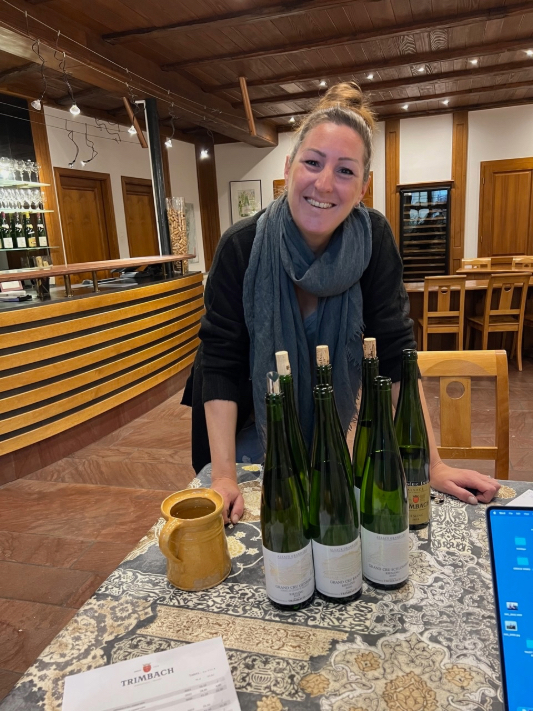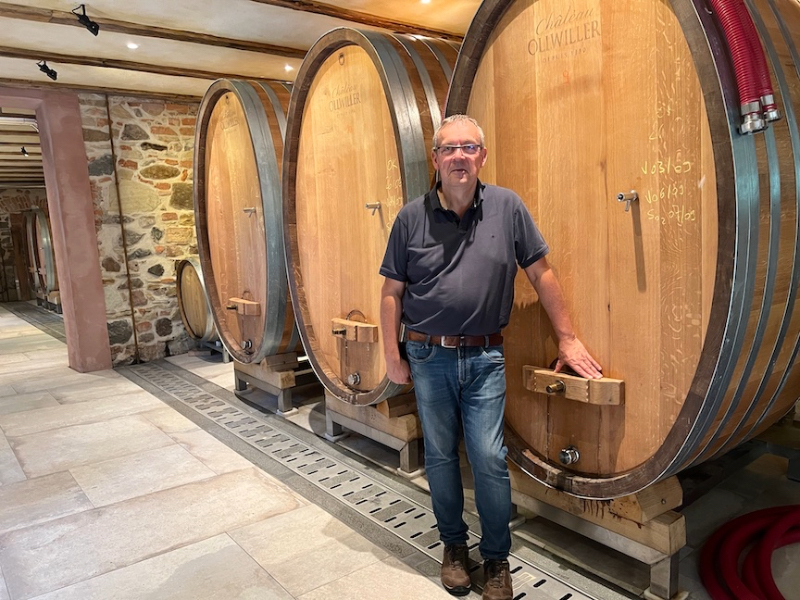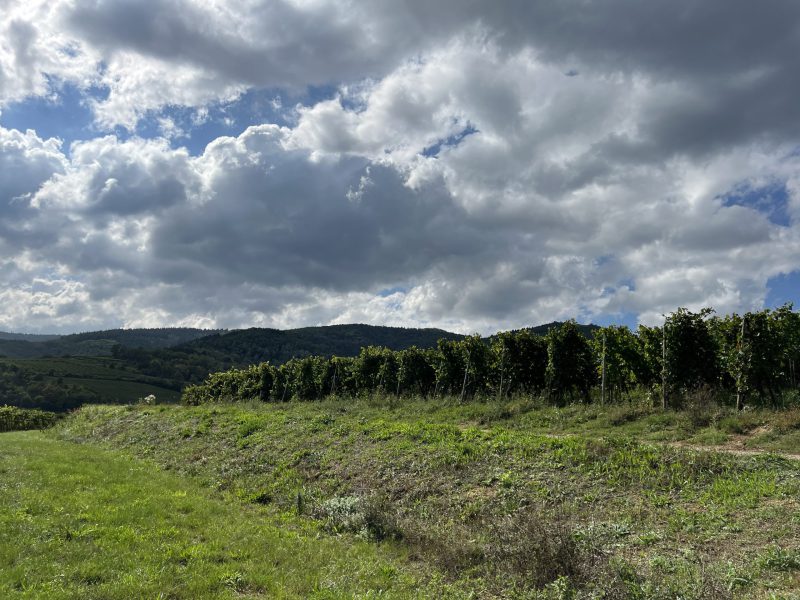Visiting Alsace last month, rain was falling as harvesters brought back grapes to ferment at Maison Trimbach in Ribeauvillé, the celebrated estate known for Alsace’s only “investment grade” wine, the famous Clos Sainte Hune Riesling. Winemaker Pierre Trimbach barely had time to shake hands, as workers brought in grapes amidst cloudy, wet weather. But his daughter Anne took time for me to taste through some excellent wines, after remarking how challenging the 2024 vintage is, with too much rainfall. “We may have to chaptalize,” she said, implying the possible need to add sugar to compensate for under-ripe grapes.
What a difference from the hot and dry 2023!

She was very kind to take time to present some wines, from basic brands that are popular with restaurants to the soon-to-be-released 2019 centennial vintage of the Riesling Clos Sainte Hune, which will have a special label, among other 2019 vintage wines. 2019 is a great vintage: “Everything was ideal,” Anne said, “it was an Instagram vintage, with just enough rain and heat, but not too much.” To be released in about two weeks from the time of this writing, the wine shows off some spice, but is mainly elegant, refined and smooth, with superb dry extract leaving a spherical impression, as if all is in place, complete with wet stone freshness conveyed in an ultra-long finish (98 Points). The 2018, by comparison, was a bit headier, and not as refined, even if its palate breadth and depth proved impressive (94).
A more affordable wine to buy is the Riesling Cuvée Fréderic Emile 2018 vintage, which exudes more evident freshness than the Clos Sainte Hune of the same vintage. This excellent wine is crafted the two Geisberg and Osterberg Grand Cru sites from 50+ year old average vines…and is amazing to drink today (95). The soils in both Grands Crus are clay and limestone over sandstone, strongly alkaline, yielding wines of powerful acidity and wet stone minerality.
Among the more recent Grand Cru wines from the estate, I especially enjoyed the Brand Grand Cru Riesling from the 2020 vintage, where vines are grown on granite and limestone now, but in 2020, it was only granite, with just 4,000 bottles. This wine is lovely with a gunflint aspect, full-bodied, and even explosive on the palate – a trait that you can get from the hot granite soils.
Alsace Pinot Noir on the Rise
But beyond the expected positives of dry whites, Alsace is producing better Pinot Noir these days, as well, as illustrated by the Maison Trimbach “Cuvée 7” Pinot Noir from the 2017 vintage, now on sale. Crafted from vines planted back in 1985, grown on red clay and limestone, this is a special Pinot Noir that is not produced every year. The grapes are 100% de-stemmed, with maceration in stainless steel, and vinified in older large wooden casks (93). They may try to experiment later with whole cluster, Anne told me, but this vintage is suave, with nicely melted tannins. It clocks in at 13.5% alcohol.
A few days later, I joined Jérôme Mader of Domaine Jean-Luc Mader in Hunawihr for a harvesters’ lunch three days before pickings ended, and he told me that the 1,100mm of rainfall over the previous 12 months was three times the amount that fell in 2023 over the same period – and twice the rainfall in an average year.
While tasting his wines – the estate is known for its bone-dry style – I was struck at just how delicious their basic Pinot Noir was, served over lunch. Cropped at 40 hectoliters per hectare, and aged eight months in old barrels, it conveys ripe cherry and charm, with the estate having been certified organic since 2010. Jérôme told me that the Pinot Noir is sold in fine Paris restaurants and at the famous Grand Épicerie de Paris, where it retails for about €18 ($19.25) – a higher boutique price, but still a good deal (92).
Indeed, I encountered other examples of fine Pinot Noir at Domaine Muré in Rouffach, where they craft wine from the recently named Grand Cru Pinot Noir appellation of Vorbourg – in July this year! Its 182 acres (73.6 hectares) spread over the southern Alsace villages of Rouffach and Westhalten, with vines on along a south/southeast facing slope.
When you taste at Domaine Muré, you get a gorgeous view of that slope. Brother and sister Véronique and Thomas – the 12th generation to run the estate – are crafting excellent and economically priced Pinot Noirs at the estate, which has been certified organic since 1999, a pioneer for organic winemaking, and biodynamic since 2013.
Their smooth and agreeable village level Domaine Muré Côte de Rouffach Pinot Noir from 2022 – which costs about €25 ($27) tax included – is worthwhile (93), but even better is their Grand Cru Vorbourg “V” 2023 with fruit brightness or “éclat” as the French say, plenty of depth, and a long finish. They picked earlier than usual to preserve freshness from this hot vintage, but did not sacrifice ripeness, as the clay and limestone soils ensured freshness. At under €40 ($43) retail, with tax included, this is superb Pinot Noir that rivals fine Burgundy. I will certainly be a buyer. I wish it were available in the United States, but if you ever go to France, buy it. The wine clocks in at 13.5% alcohol with about 4.8 grams per liter of acidity. It was aged one year, with about 25% new oak (95).
Finally, their top Grand Cru, from the monopole vineyard Clos Saint Landelin in Vorbourg, from the 2022 vintage, is less immediately appealing than the “V” but it exudes superior palate depth. As such, it needs a few years of cellaring (94). It costs between €55-60 retail, or about $62.
The success of Alsatian Pinot Noir is illustrated by its increasing percentage of total Alsace wine production, reaching 13% in 2023, the highest ever over the last 50 years, says Foulques Aulagnon of the Alsace Wine Council. Back in 1969, only 2% of all Alsace wine produced was Pinot Noir. Two reasons help explain this increase in production: higher quality, and increasing demand as consumers tire of high prices in Burgundy.
Additionally, The Bubbly Success of Crémant
Another wine that has become a big hit in Alsace is traditional-method bubbly known in Alsace as Crémant, regarding which I am even more bullish when it comes to quality – and price. In 2023, the production of Crémant also reached its highest percentage over the last half century at 33% of all Alsace wine produced – “A new record,” says Aulagnon. Indeed, many consumers find it increasingly competitive to Champagne, which – like Burgundy – has seen serious price escallation.
When it comes to Crémant, the region is no longer what it was 20 years ago, when too much Alsatian fizz was boring. Almost as an afterthought Marc Beyer of the eponymous Eguisheim estate Léon Beyer, gave me a bottle of his Crémant to try, after we tasted 20 still wines. When I opened it with a friend, it was delicious.
Alsatian Crémants are proving to be rather (positively) homogeneous in quality across more producers than ever, thanks to a tasting at Cattin, a major bubbly producer in Voegtlinshoffen. It is often said that most Crémants are not crafted with Riesling, because clients don’t like the combination of Riesling “minerality” with bubbles, but I encountered some fine Riesling-based Alsatian bubblies.

Increasing demand in France is matched by higher exports to Belgium and Denmark, then the U.S. and Italy, says Aulagnon. Alsatian Crémant Rosé is very popular in the U.S., he says, explaining that over 40% of Alsatian Crémant sold in the U.S. is Rosé. One excellent rosé is made by at Château Ollwiller, crafted by winemaker Mathieu Kauffmann, an Alsatian oenologist with 13 years’ experience at Bollinger in Champagne.
Opinions can differ, but I believe everyone can imagine encountering excellent Crémants at restaurants and asking the question, “why spend a premium for NV Champagne?”
While lunching at the superlative Buerehiesel in Strasbourg, in the gorgeous Orangerie Park, sommelier Maxime Petit poured me a Kientzler 100% Pinot Auxerrois Crémant, with only 5 grams of residual sugar that exuded balance and vivaciousness. Aged 18 months before disgorging, it has a rich, yeasty aspect as well as freshness, which nicely matched both a delectable, salty Kugelhopf pastry and a rosemary and olive tapenade.
I had a similar positive reaction to the Crémant poured by Ilona Garnier, co-owner and sommelier at the recently opened bistro La Pompette, also in Strasbourg. The Domaine Rieffel 2021 Extra Brut exudes lemon and lime zest in a rich palate but with plenty of zing as an Extra Brut should. Some three years on the lees before disgorging contributes to a classy dimension of richness.
Back at Domaine Muré, I am reminded that the estate not only produces top notch non-vintage Alsatian bubbly, but also limited edition “Grand Millésime” vintage Crémant, and the 2016 is smooth, rich, vivacious and zesty, with delicate bubbles.
Bubblies that I tasted at Cattin, which has a great wine bar overlooking Alsatian vineyards, include the following:
Cave de Ribeauvillé “Les Comtes” NV ($28): When a cooperative can make a sparkler this much fun – sweet and rich, but also with vivacity – then it is a good sign for individual producers. It blends Pinot Blanc and Auxerrois, clocking in at 12% alcohol with 5.37 grams of acidity per liter, 8 grams of residual sugar, and two years or ageing in bottle before disgorgement. 90
Domaine Bott-Geyl NV “Absolu” ($34): This blend of Pinot Blanc, Chardonnay and Pinot Noir – with one gram of residual sugar per liter, 5.5 grams of acidity per liter, and 12.5% alcohol – conveys brisk excitement, with high-toned fruit. Tasted along with other wine aficionados, we found it to be among the most photographed wines of the tasting because it is very smooth, well-aged, tart but broad, and well balanced, with verve and a long finish. 94
Domaine Etienne Loew NV ($28): This NV blend of Pinot Blanc and Chardonnay would please lovers of more acidic bubbly, as it comes across a bit tart. Likely made from grapes harvested relatively early, with notes recalling lemon, fennel, lime and coriander seed. As it sits in glass, it turns out to be rather fascinating – sure, high toned – and best suited to cuisine rather than a stand-alone sipper. Try it with shrimp cocktail. It holds 12.42% alcohol and 1.8 grams of residual sugar, with 6.7 grams of acidity per liter. 93
Domaine Frédéric Mochel NV Brut ($24): This is another producer who crafts excellent bubbly, though one should keep in mind the vintages blended into any particular release, as they can vary as a result. This particular NV, a blend of Pinot Noir and Chardonnay (with over 7 grams of acidity per liter, 4.3 grams of residual sugar and 12.34% alcohol, aged over two years before disgorgement) was excellent, with tangy kiwi and grapefruit notes lending plenty of verve. This is lots of fun to drink, and it would be perfect for freshly-shucked oysters. 93
Gustave Lorentz “Zero Dosage” 2021 ($24): This vintage bubbly blends Pinot Blanc, Chardonnay and Pinot Noir, clocking in at 12.5% alcohol with 6.6 grams of acidity and 1.52 grams of residual sugar. Aged 24 months before disgorgement, it gives off a refined floral aspect with some fascinating espresso-like notes delivered with finesse in the bubbles. The finish is not steely, as some non-dosage wines can be. 92
Justin Boxler “Bulles de Pinots” 2020 ($40): This blend of four Pinots (Noir, Blanc, Gris, Auxerrois) with zero residual sugar, 3.93 grams of acidity, 12.5% alcohol and aged 23 months before disgorgement, conveys minty freshness and ripe fruit: no need for added sugar. It exudes the sunny ripeness of the vintage with fine palate texture, and is a vinous bubbly that can pair well with roast chicken or veal in a cream sauce. Solid stuff! 93
Domaine Mann Vignoble des 3 Terres 2020 Brut Nature ($40): This was named to distinguish itself from the eponymous Albert Mann estate, and it comes across as one of the top Crémants of the tasting, with plenty vivacity, juiciness and orchard fruit ripeness. There is also a sense of salty caramelized red apple richness, ideal for autumn. An excellent sparkler, it clocks in at 12.5% alcohol, 7 grams of acidity per liter, 2.7 grams of residual sugar, and 29 months or ageing in bottle before disgorgement. 94
Cattin Sauvage NV $24): This blend of 85% Pinot Blanc and 15% Chardonnay, with 6 grams of residual sugar and plenty of balancing acidity is brisk yet opulent. It is an excellent mid-priced bottle of Crémant, conveying fresh floral aromas with a creamy mid palate nicely framed by persistent flavors recalling tangy red apples and white orchard fruits. 93
. . .
Photos by Panos Kakaviatos

